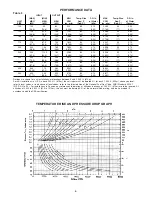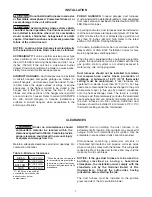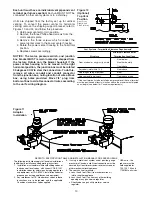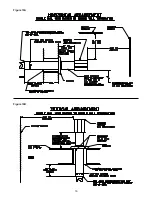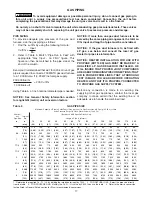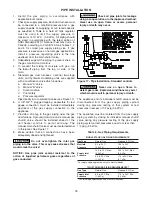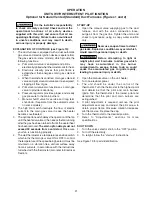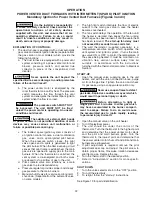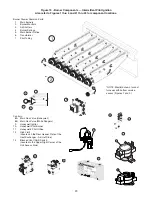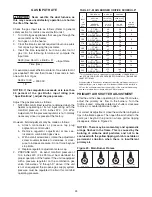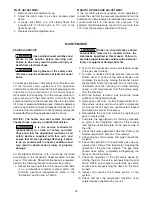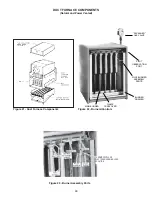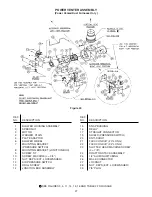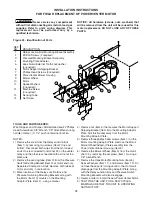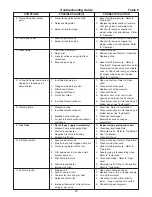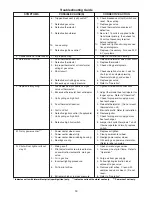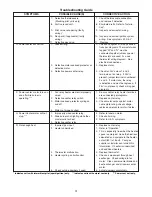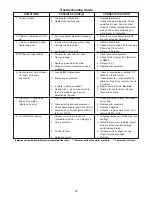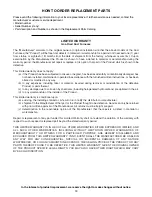
19
OPERATION
NATURAL VENTED UNITS WITH STANDING PILOT (Figures 1 and 2)
It is the installer’s responsibility
to check all safety controls! Check and test the
operational functions of all safety devices
supplied with this unit, and ensure that all are
operating effectively. Failure to do so could result
in unsafe conditions and may result in death,
serious injury or property damage.
EXPLANATION OF CONTROLS (see Figure 18):
1.
The duct furnace is equipped with a combination gas
control valve which provides the following functions.
a.
Manual main gas valve controls the flow of gas to
the unit heater.
b.
Pilot gas valve controls flow of gas to the pilot
burner.
c.
Pilot safety switch interrupts flow of gas
completely if pilot is not lit.
d.
Pressure regulator provides proper and steady
gas pressure to the main burners.
e.
24 volt solenoid valve controls flow of gas to main
burners and is operated by the wall thermostat.
2.
The high limit switch interrupts the flow of electric
current to the main gas valve in case the heater
becomes overheated.
3.
The optional fan switch delays the operation of the
fan until the heater is warmed, then keeps the fan
running after the gas has been turned off until the
useful heat has been removed.
The startup fan
delay must not exceed 90 seconds from a cold
start.
Make sure your fan is functioning properly.
4.
The wall thermostat is a temperature sensitive
switch which turns the main gas valve ON or OFF to
control the temperature of the space being heated. It
must be mounted on vibration-free, vertical surface
away from air currents, in accordance with the
instructions furnished with the thermostat. Not
standard equipment. (Also refer to Electrical
Section).
Never use an open flame to detect
gas leaks. Explosive conditions may exist which
would result in personal injury or death.
START-UP
Open the manual shutoff gas valve to the duct furnace
and, with the union connection loose, purge air from the
gas line. Tighten the union and check for leaks, using a
soapy water solution only.
Never use an open flame to detect
gas leaks. Explosive conditions may exist which
would result in personal injury or death.
Light the pilot as follows:
1.
Close the main and pilot gas supply by depressing
and turning gas cock dial to OFF. Refer to Figure
18 for burner component identification.
2.
Turn the thermostat to the OFF position or lowest
temperature setting on the dial.
Before attempting to light or
relight the pilot, wait five minutes to allow gas
which may have accumulated in the burner
compartment to escape. Failure to do so could
cause the accumulated gas to ignite rapidly,
leading to personal injury or death.
3.
Turn the gas cock dial to PILOT position.
4.
Depress and hold the gas cock or red bottom dial
while lighting the pilot burner. Allow the pilot to
burn for approximately 30 seconds before releasing.
If the pilot does not remain lit, repeat the operation
allowing a longer period of time before releasing.
5.
If pilot adjustment is required, remove the pilot
adjustment cap and adjust the pilot key to obtain
proper flame. Replace the cap.
NOTICE: A proper pilot flame is soft steady flame
that envelops 3/8-inch to 1/2-inch (9.5 to 12.7 mm)
of the thermocouple tip.
6.
Turn the gas cock dial to the ON position.
7.
Turn the thermostat to the desired position.
8.
Check gas input rate (see adjustments)
SHUT-DOWN
1.
Turn the valve selector knob to the OFF position.
2.
Turn off the electricity.
3.
To relight, follow the “START-UP” instructions
above.
Summary of Contents for NATURAL INDOOR GAS-FIRED DUCT FURNACE
Page 14: ...14 Figure 12A Figure 12B...
Page 15: ...15 Figure 13A Figure 13B...
Page 34: ...34 NOTES...
Page 36: ......


